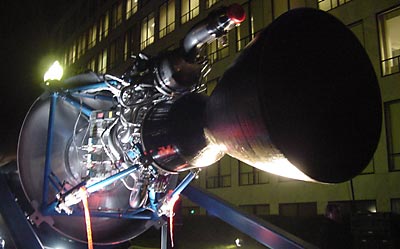The Falcon and the showman<< page 1: introducing the Falcon 5 Falcon 5 versus the competitionThe Falcon 5 represents a change in direction for SpaceX. Previously, the company had talked about developing a “Falcon Heavy”, which would have used two additional first stages strapped onto the core first stage, analogous to the Delta 4 Heavy. In fact, information about the company distributed at the reception still listed the Falcon Heavy along with the “Falcon Standard”, now called Falcon 1. Musk later said that, from a reliability standpoint, the Falcon 5 was a better approach than the Falcon Heavy. The Falcon 5 also offers a larger payload capacity: the Heavy was designed to put 2,000 kg into LEO and 750 kg into GTO. Musk said there are no longer any plans to develop the Falcon Heavy. The Falcon 5 also stakes out new territory for the company. The Falcon 1—and its $6-million price tag—was billed as a “Pegasus killer” because it could launch more than Orbital Sciences Corporation’s air-launched vehicle, which costs NASA up to $30 million a launch. The Falcon 5, meanwhile, takes aim at a different competitor: Boeing and its Delta 2. The Falcon 5 lies, in terms of performance, between the “Med-Lite” Delta 7420, with a LEO capacity of 3,100 kg, and the larger Delta 7920, with a LEO capacity of nearly 5,000 kg. In terms of cost, though, there is little comparison. One year ago NASA announced it has selected the Delta 2 for up to 19 launches between 2006 and 2009, for a total contract value of $1.2 billion. That’s an average of over $60 million a launch, five times the Falcon 5 price.
Another comparable vehicle to the Falcon 5 is the Dnepr, a converted Russian SS-18 ICBM. The Dnepr can place up to 3,700 kg into LEO for a price comparable to the Falcon 5: an estimated $10-15 million. The Dnepr, however, has seen little activity, with only three launches since its introduction in 1999 (a fourth is currently scheduled for the second quarter of 2004.) This raises the question of what market, if any, exists for the Falcon 5. The vehicle may offer the best of both worlds for US customers, providing low-cost launches without the export control hassles of launching from Russia. However, there’s been little non-US interest in the Dnepr’s cheap launches, and NASA, the primary customer for this class of payload in the US, is committed to the Delta 2 for at least the next several years. SpaceX did drop a hint of one market it was considering: the company noted that the Falcon 5 will be capable of “carrying supplies to the International Space Station with the addition of a lightweight automated transfer vehicle.” Near-term plansWhile it’s all well and good to talk about grandiose plans for the future, the fact remains that SpaceX has yet to conduct a launch of the Falcon 1. That first launch, of the Defense Department’s experimental TacSat-1 spacecraft, is now planned for late March, according to Musk. The second launch, for an unspecified foreign customer (rumored to be Malaysia), is planned for later next year. Patti Grace Smith, associate administrator for commercial space transportation (AST) at the FAA, congratulated Musk during brief remarks after Musk announced the Falcon 5. “The Falcon, like several entrepreneurial efforts to develop lower cost, reusable vehicles, represents the direction US commercial space transportation needs to go, and must go,” she said.
While the first Falcon 1 launch is for the military, and thus not licensed by FAA/AST, she noted that her office has been “fully engaged” with SpaceX on the technical aspects of the vehicle through a memorandum of understanding with the Air Force. “I wish you the best for the Falcon’s maiden voyage, and for many successful launches beyond that,” she told Musk, “and to your second launch, because we get to license it.” In his earlier comments during the reception inside the museum, Musk acknowledged the painful history of launch vehicle development, notably the fact that the initial launches of many new launch vehicles end in failure. “It’s going to be a long path between here and a successful launch,” he said. “It’s possible that the first launch will not be successful.” Musk has previously stated, though, that the company is in it “for the long haul” even if the vehicle initially fails. Although the fate of the Falcon’s first launch, and of the vehicle in general, remains uncertain, one thing is clear: if SpaceX keeps developing larger rockets, it will soon be infeasible to ship them cross-country for events in downtown Washington. That might not be such a bad thing: while the Falcon looked fine sitting on Independence Avenue in Washington, one suspects it will look a lot better lifting off from Vandenberg next year. Home |
|
